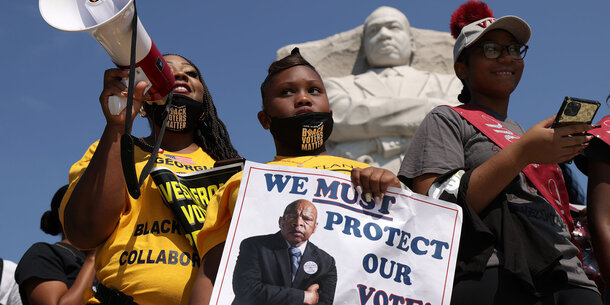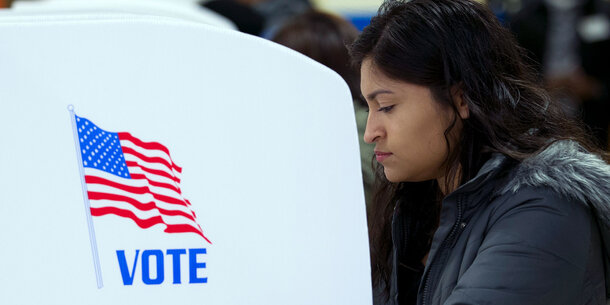The False Narrative of Vote-by-Mail Fraud
Mail ballots are essential for holding a safe election amid Covid-19, and security concerns can be easily addressed.

If we are to have safe, healthy, and fair elections this year in the face one of the worst pandemics in a century, Americans must make widespread use of mail ballots. Election administrators and other leaders from across the political spectrum have urged support to make the necessary adjustments to their election infrastructure. They recognize we have no choice. Most Americans, including a majority of Republicans, agree.
President Trump and his allies, however, are pushing back against this option, raising spurious claims that fraudulent mail ballots will contaminate the election. “I think a lot of people cheat with mail-in voting,” Trump said earlier this week. “Mail in voting is a terrible thing. . . . I think if you vote, you should go,” he later added, not long after he requested a vote-by-mail ballot for the Florida primary. Shortly afterward, Republican National Committee Chairwoman Ronna McDaniel echoed the president in a Fox News op-ed. (This is in sharp contrast to former chairman Michael Steele, who coauthored an op-ed arguing that “the current emergency demands expanded use of vote-by-mail,” and that “democracy depends on it.”)
Trump’s claims are wrong, and if used to prevent states from taking the steps needed to ensure public safety during November’s election, they will be deadly wrong. Mail ballot fraud is incredibly rare, and legitimate security concerns can be easily addressed.
Mail balloting is not a newfangled idea; it was already deeply embedded in the American electoral system before the coronavirus hit. In the last two federal elections, roughly one out of every four Americans cast a mail ballot. In five states — Colorado, Hawaii, Oregon, Utah, and Washington — mail balloting has been the primary method of voting. In 28 additional states, all voters have had the right to vote by mail ballot if they choose, without having to provide any reason or excuse. Over time, a growing number of voters have chosen that option. Since 2000 more than 250 million votes have been cast via mailed-out ballots, in all 50 states, according to the Vote at Home Institute. In 2018, more than 31 million Americans cast their ballots by mail, about 25.8 percent of election participants.
Despite this dramatic increase in mail voting over time, fraud rates remain infinitesimally small. None of the five states that hold their elections primarily by mail has had any voter fraud scandals since making that change. As the New York Times editorial board notes, “states that use vote-by-mail have encountered essentially zero fraud: Oregon, the pioneer in this area, has sent out more than 100 million mail-in ballots since 2000, and has documented only about a dozen cases of proven fraud.” That’s 0.00001 percent of all votes cast.*** An exhaustive investigative journalism analysis of all known voter fraud cases identified only 491 cases of absentee ballot fraud from 2000 to 2012. As election law professor Richard L. Hasen notes, during that period “literally billions of votes were cast.” While mail ballots are more susceptible to fraud than in-person voting, it is still more likely for an American to be struck by lightning than to commit mail voting fraud.
States have multiple tools to address valid security concerns and protect election integrity when it comes to mail ballots. And recent technologies and strategies have significantly enhanced the security of mail balloting.
- Identity verification: The principal method used to detect and prevent fraud is the mail ballot envelope itself, where each voter must include personal identifying information (such as address, birthday, and driver’s license number or last four digits of a Social Security number). In most states, that information includes a signature that can be used to match against the voter rolls. The voter’s remaining personal information is also matched against the information stored on the voter rolls. As Kim Wyman, Washington’s Republican secretary of state, explained, “we actually compare every single signature of every single ballot that comes in and we compare it and make sure that it matches the one on their voter registration record.” This is a long-standing and well-established practice to ensure that the ballot received was indeed cast by the correct voter. It’s important to note though that there are best and worst practices with signature matching. When done incorrectly, it can disenfranchise eligible voters. Done correctly — with signature matching software, bipartisan review by officials trained in signature verification, and outreach to flagged voters — it is an effective deterrent for fraud.
- Bar codes: Most election jurisdictions now use some form of bar code on their ballot envelopes. These bar codes allow election officials to keep track of ballot processing and help voters know whether their ballot has been received. Bar codes also allow states to identify and eliminate duplicate ballots if a voter casts more than one, whether mistakenly or corruptly.
- Ballot tracking through the U.S. Postal Service: In many jurisdictions, including California, Colorado and Florida, ballot envelopes are equipped with intelligent mail bar codes linked to the postal service that enable voters and election officials alike to track an envelope from drop-off to delivery and processing at the local administrator’s office. Denver’s elections division reported that 17,931 people used its system to track the status of their ballots during the November 2013 election. While relatively new, these ballot tracking systems are now readily available and are easily operable at scale. This way, if a voter says they never received their ballot, states can better determine whether the ballot was delivered, replace the ballot as appropriate, and ensure the original is flagged as compromised and not counted.
- Secure drop-off locations and drop boxes: Multiple ballot return options limit the opportunity for ballot tampering by fostering voter independence in returning a ballot. A common layer of security to ensure that ballots are not stolen or tampered with — at least for voters who can leave their homes — is secure drop-off locations. In places where all or most voters receive ballots by mail, many voters do not mail completed ballots; rather, they opt to drop their ballots off at secure polling sites. According to the Survey of the Performance of American Elections at Harvard University in 2016, 73 percent of voters in Colorado, 59 percent in Oregon, and 65 percent in Washington returned their ballots to some physical location, such as a drop box or local election office.
Ballot drop-off locations help maintain a secure chain of custody as the ballot goes from the voter to the local election office. And when drop boxes are put outside of government offices, one security measure is to equip them with security cameras to monitor ballot traffic and ensure that the boxes are not breached. (Drop boxes in government buildings benefit from existing video security systems.) In addition to preventing fraud, secure drop-off locations enable voters to be confident that their ballots will be received on time. - Harsh penalties: Anyone who commits voter fraud using a mail ballot risks severe criminal and civil penalties: up to five years in prison and $10,000 in fines for each act of fraud under federal law, in addition to any state penalties. In Oregon, for example, voting with or signing another person’s ballot is a Class C felony punishable by up to five years in prison. These penalties provide a strong deterrent to voter fraud; it makes no sense to risk such significant punishment for one additional vote.
- Postelection audits: In 2018, a review of returned absentee ballot records helped identify anomalies in the election results of Bladen County, North Carolina, enabling election officials to uncover election interference by a political operative who stole and tampered with mail ballots. Postelection audits, which many jurisdictions are starting to adopt, would more systematically enable election officials to identify any irregularities or misconduct in the vote. Audits typically use statistical techniques to review a sample of ballots cast in an election to ensure that votes were recorded and tallied accurately. Since audits can only be meaningfully carried out when there is a voter-verified paper record of each vote, mail ballots (which are paper-based), are conducive to effective audits. Postelection audits are already widely used in states that use mail voting and are a best security practice for all elections regardless.
- Polling sites as a fail-safe: Finally, if there are concerns that an eligible voter’s mail ballots could be lost or uncounted, in-person polling sites provide a mechanism to correct problems, provide essential services, and ensure that every eligible voter can cast a valid ballot. No system that relies on mail balloting can operate without accessible in-person voting sites, both for those who cannot or will not vote by mail and as a fail-safe to the inevitable problems that may arise. Election administration glitches, mail delivery problems, and data errors can prevent voters from receiving or submitting their ballots. Other voters, including many on Native American reservations, simply lack reasonable access to mail. And inconsistent ballot counting practices cause mail ballots in some communities to be rejected unfairly, or at higher rates. These are problems of access and administration, not fraud. And they can be readily solved at polling sites.
***Correction: An earlier version misstated the percentage of vote-by-mail fraud in Oregon since 2000. It is 0.00001 percent of all votes cast not 0.0000001 percent.






